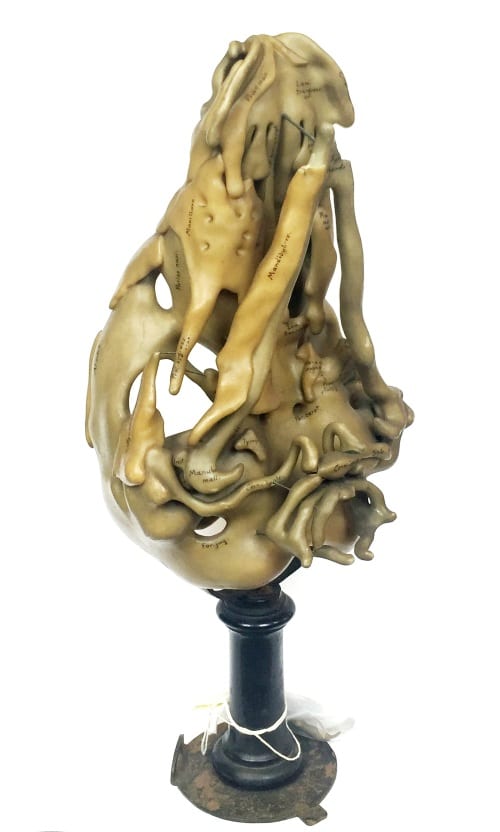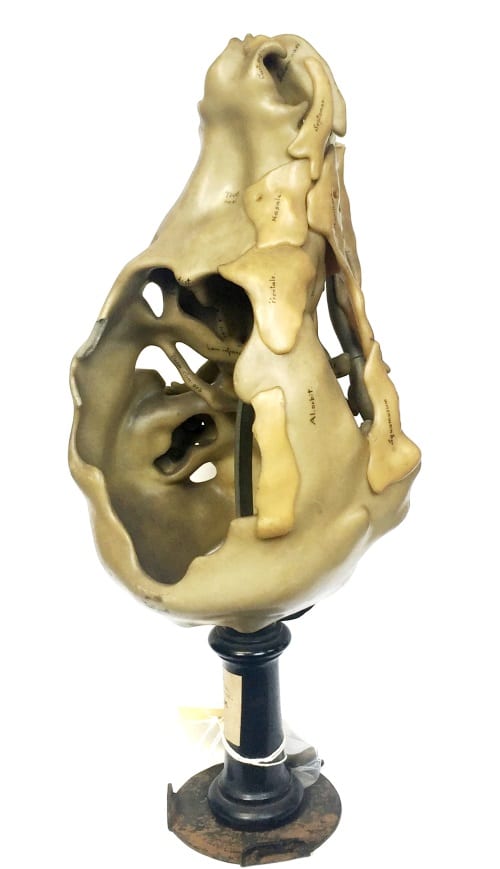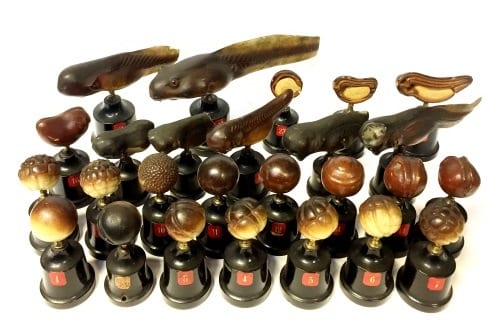Specimen of the Week 322: The Primordial Skull
By Tannis Davidson, on 22 December 2017
Season’s greetings! As presents appear under Christmas trees, the anticipation and excitement grows as recipients wonder what treasures lie wrapped among the dropping needles. In the spirit of mystery giving, this week’s Specimen of the Week is one to puzzle over in curiosity: what could it be? It is already unwrapped, stripped down, revealing all. However, even when seen, it is not obvious what it is…
**The Primordial Skull of Echidna Model**

LDUCZ-Z1103 Tachyglossus aculeatus. ‘Primordial skull of echidna’. F. Ziegler after Ernst Gaupp. 1908.
This magnificent specimen was sculpted from the very best of early twentieth century scientific Freiburgian wax – that is, it was made in 1908 by the Ziegler studio in Freiburg, Germany as a teaching model to be used in university classrooms.
The Ziegler’s wax modelling studio had been established by Adolf Ziegler in the 1850’s while he was a zootomical assistant in the physiological institute of Freiburg University, where he had also begun to practice medicine. It was here that Ziegler partnered with Alexander Ecker, the university’s new professor of physiology, zoology and comparative anatomy, to produce a series of wax models of the development of frog embryos. The wax models were created to not only compliment Ecker’s existing teaching aids (drawings, charts and engraved plates), but were considered essential in order to visualise features in the round. [1]
Ziegler and Ecker dissected specimens, then drew and hand-shaped several embryological wax model series such as the ‘development of the heart in man’ (1858), ‘external form of human embryos’ (1858-1861) and ‘development of brain convolutions’ (1868-1869). Together, the method and the models would shape not only the future of Ziegler’s studio but also change the way embryology was taught.
In the years that followed, Adolf and (later) his son Friedrich would continue to collaborate with anatomists and particularly embryologists. Planned from the outset, such partnerships would prove to be of mutual benefit. Through models, developmental series could be scaled up for handling and closer inspection and therefore be used more effectively in classroom teaching. In turn, creating and advertising models ‘after Professor X’ gave the waxes an academic credibility and relevance. [2]
Many notable scientists worked with the Zieglers such as August Weismann (influential evolutionary theorist known for germ plasm theory which rebuked Lamarckism), Wilhelm His (known for his groundbreaking studies of the development of the nervous system in human embryos) and Ernst Haeckel (zoologist, artist, embryology theorist and populariser of Darwinism).

LDUCZ-G520 Fabricia sp. Part of the series ‘Types of cleavage and gastrulation’. Adolf Ziegler after Ernst Haeckel. 1876.
The primordial echidna model was a collaboration by Friedrich Ziegler and anatomist Ernst Gaupp. Gaupp, a student of Robert Wiedersheim (who had succeeded Ecker as the director of Freiburg’s Institute of Anatomy and Comparative Anatomy) shared his teacher’s inclination towards embryology rather than comparative anatomy to discover laws of form (morphology).[3] Gaupp’s research of morphological development of the cranium in vertebrates established the methodology for modern cranial morphological research.
Gaupp is best known for the Reichert-Gaupp theory which explains the evolution of mammalian ear bones from reptile jaw bones – one of the most important evolutionary events demonstrating both transitional forms and the re-purposing of structures during evolution. It is a critical line of evidence in demonstrating mammals’ position in nature.
His research and advancement of Reichert’s previous 1837 work on the subject occurred during his time in Frieburg in which he worked with Friedrich Ziegler producing several wax models: ‘primordial skull of Rana fusca’ (1895), ‘primordial skull of a lizard’ (1900-1902), ‘primordial skull of Rana fusca’ (mature) (1902), and finally, our Specimen of the Week the ‘primordial skull of echidna'(1908).[4]

LDUCZ-Z1103 Tachyglossus aculeatus. ‘Primordial skull of echidna’. F. Ziegler after Ernst Gaupp. 1908.
The primordial echidna skull model was the physical embodiment of the culmination of Gaupp’s pioneering work in the field of cranial morphology. Although Gaupp continued to refine his work in later years, this would be his last Ziegler model.
This model was more than just the product of its time and place, but a symbol of the collective scientific energy and artistic innovation which gave birth to academic science as we know it. It is representative of the power of partnership and cooperation.
To a joyful present and a well remembered past. Best wishes for Happy Holidays!
Tannis Davidson is the Curator of the Grant Museum of Zoology
References
[1] de Chadarevian, Soraya and N. Hopwood. 2004. Models: The Third Dimension of Science (Writing Science). Stanford University Press. Pg175.
[2] Hopwood, Nick. 2002. Embryos in wax Models from the Ziegler studio. Whipple Museum of the History of Science, University of Cambridge and Institute of the History of Medicine, University of Bern. Pg25.
[3] Nyhart, Lynn K. 1995. Biology Takes Form: Animal Morphology and the German Universities, 1800-1900. University of Chicago Press. Pg217.
[4] Gaupp, Ernst. 1908. Zur Entwickelungsgeschichte und vergleichen Morphologie des Schädels von Echidna aculeata var. ehenden typical [On the developmental history and comparative morphology of the skull of Echidna aculeata var. typical]. Richard Semon Fortschungsreisen (in German). 3: 539–788.
 Close
Close


